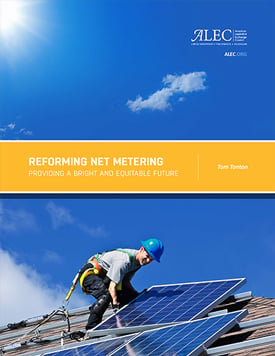New Publication on Net Metering Reform
 For the sake of this exercise, imagine that you have a sizable vegetable garden in your back yard. One year you decide to plant tomatoes and because of optimal sunshine and rain you end up having a bumper crop at harvest. You have so many tomatoes that even after eating many yourself and giving some away to friends and family, you have more than you know what to do with.
For the sake of this exercise, imagine that you have a sizable vegetable garden in your back yard. One year you decide to plant tomatoes and because of optimal sunshine and rain you end up having a bumper crop at harvest. You have so many tomatoes that even after eating many yourself and giving some away to friends and family, you have more than you know what to do with.
Now imagine a government passing a law requiring your local grocery store to purchase your surplus tomatoes at the retail rate, precisely the same price that they will then in turn charge other customers for those same tomatoes. In other words, the grocer stands to make no money to pay for his expenses (e.g., rent, maintenance, electricity, wages, etc.) much less any profit even when he can purchase tomatoes elsewhere at a much lower wholesale cost.
Well, thankfully such a tomato mandate doesn’t exist in any of the fifty states, but unfortunately similar policies do. Only instead of tomatoes, we’re dealing with electricity generated from small-scale, onsite distributed generation (DG) sources. Forty-three states plus the District of Columbia have mandatory net metering policies on the books which statutorily require a utility to purchase surplus electricity from a DG customer, oftentimes at the full retail rate.
Embedded in the retail rate of one kWh of electricity is not just the cost to generate electricity from a particular source, but also the cost to build and maintain transmission and distribution infrastructure necessary to deliver that electricity to homes and businesses. Additionally, there are other costs associated specifically with DG and net metering, such as the use of the electric grid to send surplus electricity to another customer and continuous monitoring of DG generation on the part of the utility to ensure no interruption of service when a DG customer goes to flip their light switch. By being compensated at the full retail rate for the surplus electricity that they generate, DG customers are, in effect, able to avoid paying for these vital services that they utilize.
A recently released report titled Reforming Net Metering: Providing a Bright and Equitable Future and published by the American Legislative Exchange Council identifies and fully explains the implications of this cost shift and other problems associated with existing net metering policies in the states. In addition, the report also discusses the importance and value of the electric grid, the need for modernizing and maintaining the grid, and analyzes net metering from a competitive market perspective. Finally, the report offers states suggestions of how they can reform existing policies to make them fairer and more practical.
You can view the full report at http://www.alec.org/net-metering-reform/.
